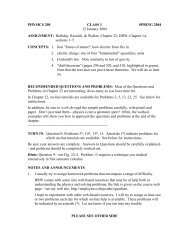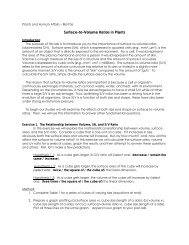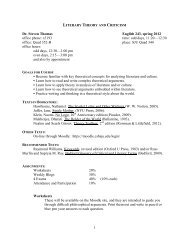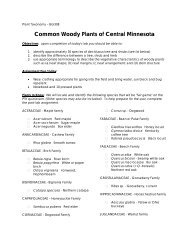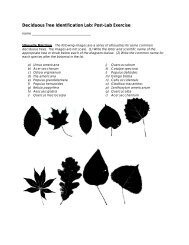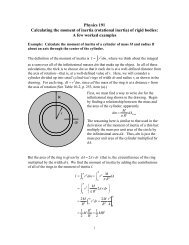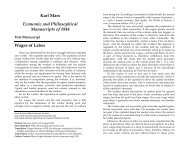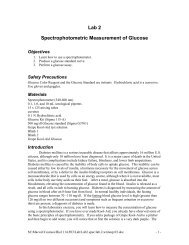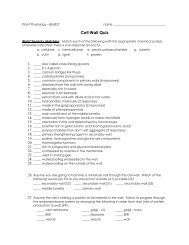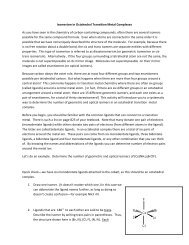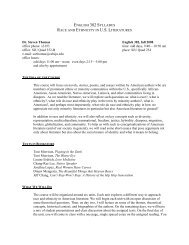Lab 1: The metric system â measurement of length and weight
Lab 1: The metric system â measurement of length and weight
Lab 1: The metric system â measurement of length and weight
You also want an ePaper? Increase the reach of your titles
YUMPU automatically turns print PDFs into web optimized ePapers that Google loves.
<strong>The</strong> mean is simply the mathematical average <strong>of</strong> the data. <strong>The</strong> mean provides you with aquick way <strong>of</strong> describing your data, <strong>and</strong> is probably the most used measure <strong>of</strong> centraltendency. However, the mean is greatly influenced by outliers. An outlier is anobservation in a data set which is far removed in value from the others in the data set. Itis an unusually large or an unusually small value compared to the others. For example,consider the following data set: 1, 1, 2, 4, 5, 5, 6, 6, 7, 150.While the mean for this data set is 18.7, it is obvious that nine out <strong>of</strong> ten <strong>of</strong> theobservation lie below the mean because <strong>of</strong> the large final observation. Consequently, themean is not always the best measure <strong>of</strong> central tendency.<strong>The</strong> median is the middle observation in a data set. That is, 50% <strong>of</strong> the observation areabove the median <strong>and</strong> 50% are below the median (for sets with an even number <strong>of</strong>observation, the median is the average <strong>of</strong> the middle two observation). <strong>The</strong> median is<strong>of</strong>ten used when a data set includes outliers. In the example above the median is 5 – inthis example the median is a better measure <strong>of</strong> central tendency than the mean, due to thepresence <strong>of</strong> an outlier.St<strong>and</strong>ard deviation is a measure <strong>of</strong> the spread or dispersion <strong>of</strong> a set <strong>of</strong> data. <strong>The</strong> morewidely the values are spread out, the larger the st<strong>and</strong>ard deviation. For example, say wehave two separate lists <strong>of</strong> exam results from a class <strong>of</strong> 30 students; one ranges from 31%to 98%, the other from 82% to 93%, then the st<strong>and</strong>ard deviation would be larger for theresults <strong>of</strong> the first exam.a. Open MS Excel by double clicking on the respective icon on the desktop <strong>of</strong> yourcomputer. <strong>The</strong> program will open <strong>and</strong> a window showing Workbook 1 will appear. <strong>The</strong>workbook is a spreadsheet with columns <strong>and</strong> rows that you will use to enter data. Eachindividual “rectangle” in the workbook is referred to as a “cell”.Columns are denoted alphabetically – A, B, C – <strong>and</strong> rows are identified numerically – 1,2, 3, etc. <strong>The</strong> location <strong>of</strong> a cell is indicated by its column <strong>and</strong> row coordinates – forexample, the cell located at the very top left <strong>of</strong> your screen is cell “A1”.b. Highlight cell B1 <strong>and</strong> type in “Height” – this is the title for the column where you willenter the data for class height you collected above. Highlight cell D1 <strong>and</strong> type in “Leg<strong>length</strong>” – this is the title for the column where you will enter the data for class leg <strong>length</strong>you collected earlier.Get the data from the chalkboard <strong>and</strong> enter each individual data point in a cell – hit the“Enter” key or use the mouse to move the cursor to the next cell in the column.c. Descriptive statisticsGo to a cell below the last data point you entered in the column entitled “Height”.Highlight this cell <strong>and</strong> then click on the “=” sign on the upper left corner <strong>of</strong> the Exceltoolbar – a dialog box will appear.



